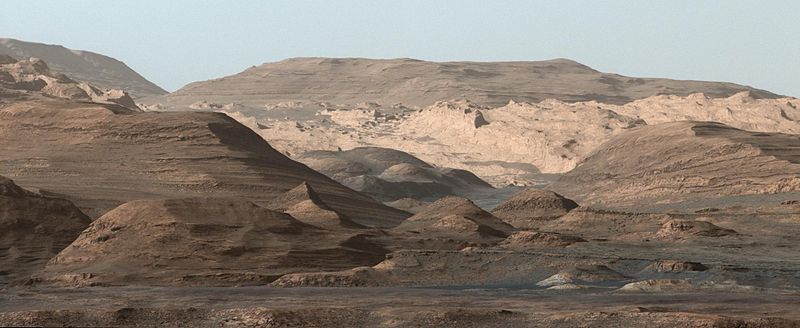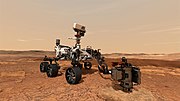Timeline of Mars Science Laboratory

The
Prelaunch (2004–2011)
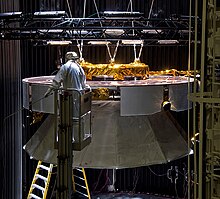
In April 2004, the United States
Testing of components also began in late 2004, including Aerojet's monopropellant engine with the ability to throttle from 15 to 100 percent thrust with a fixed propellant inlet pressure.[2] By November 2008 most hardware and software development was complete, and testing continued.[5] At this point, cost overruns were approximately $400 million.[6] In December 2008, lift-off was delayed to November 2011 due to insufficient time for testing and integration.[7][8][9]
Between 23–29 March 2009, the general public ranked nine finalist rover names (Adventure, Amelia, Journey, Perception, Pursuit, Sunrise, Vision, Wonder, and Curiosity)[10] through a public poll on the NASA website.[11] On 27 May 2009, the winning name was announced to be Curiosity. The name had been submitted in an essay contest by Clara Ma, a then sixth-grader from Kansas.[11]
Landing site selection
At the first MSL Landing Site workshop, 33 potential landing sites were identified.[12] By the second workshop in late 2007, the list had grown to include almost 50 sites,[13] and by the end of the workshop, the list was reduced to six;[14][15][16] in November 2008, project leaders at a third workshop reduced the list to these four landing sites:[17][18][19]
| Name | Location | Elevation | Notes |
|---|---|---|---|
| Eberswalde Crater | 23°52′S 326°44′E / 23.86°S 326.73°E | −1,450 m (−4,760 ft) | Ancient river delta.[20] |
| Holden Crater | 26°22′S 325°06′E / 26.37°S 325.10°E | −1,940 m (−6,360 ft) | Dry lake bed.[21] |
| Gale Crater | 4°29′S 137°25′E / 4.49°S 137.42°E | −4,451 m (−14,603 ft) | Features 5 km (3.1 mi) tall mountain of layered material near center.[21][22] selected.[23] |
| Mawrth Vallis | 24°01′N 341°02′E / 24.01°N 341.03°E | −2,246 m (−7,369 ft) | Channel carved by catastrophic floods.[24] |
A fourth landing site workshop was held in late September 2010,[25] and the fifth and final workshop 16–18 May 2011.[26] On 22 July 2011, it was announced that Gale Crater had been selected as the landing site of the Mars Science Laboratory mission.
Launch (2011)
MSL was launched from
On 13 December 2011, the rover began monitoring space radiation to aid in planning for future crewed missions to Mars.[33]
The interplanetary journey to Mars took more than eight months,[34] time during which, the spacecraft performed four trajectory corrections: on 11 January, 26 March, 26 June and on 28 July. Mission design had allowed for a maximum of 6 trajectory correction opportunities.[35][36]
Landing (2012)
Curiosity landed in the
Some low resolution Hazcam images were beamed to Earth by relay orbiters confirming the rover's wheels were deployed correctly and on the ground.[40][47] Three hours later, the rover begins to beam detailed data on its systems' status as well as on its entry, descent and landing experience.[47] Aerial 3-D images of the landing site are available and include: the Curiosity rover and related Parachute (HiRISE, 10 October 2012).
On 8 August 2012, Mission Control began upgrading the rover's dual computers by deleting the entry-descent-landing software, then uploading and installing the surface operation software;[48] the switchover was completed by 15 August.[49]
-
The Curiosity rover lands on the surface of Mars (video-03:26; August 6, 2012).[50]
-
MSL debris field - parachute landed 615 m from Curiosity (3-D: rover & parachute) (August 17, 2012; MRO).
-
Engineers at NASA's Jet Propulsion Laboratory celebrate the landing.[52]
-
Curiosity rover - women team members (June 26, 2014).
-
Curiosity landed on August 6, 2012,Mount Sharp).[53]
-
First colored image from Curiosity (August 6, 2012).
-
Curiosity's self-portrait - with closed dust cover (September 7, 2012).
-
Curiosity's self-portrait (September 7, 2012; color-corrected).
-
Gravel below one of the 6 wheels on the rover.
Prime mission (2012 - September 2014)
On 15 August 2012, the rover began several days of instrument checks and mobility tests.[56][57] The first laser testing of the ChemCam by Curiosity on Mars was performed on a rock, N165 ("Coronation" rock), near Bradbury Landing on 19 August 2012.[58][59][60]
The science and operations teams have identified at least six possible routes to the base of
Having completed its mobility tests, the rover's first drive began on 29 August 2012, to a place called Glenelg about 400 m (1,300 ft) to the east.[63] Glenelg is a location where three types of terrain intersect, and is the mission's first major driving destination. The drive across may take up to two months, after which Curiosity will stay at Glenelg for a month.[64]
On the way, Curiosity studied a pyramidal rock dubbed "Jake Matijevic" after a mathematician-turned-rover-engineer who played a critical role in the design of the six-wheeled rover, but died just days after Curiosity landed in August. [65] The Jake rock measures about 25 cm (9.8 in) tall and 40 cm (16 in) wide.[66] It is an igneous rock and may be a mugearite, a sodium rich oligoclase-bearing basaltic trachyandesite.[67] Afterwards, on 30 September 2012, a finely-grained rock, named "Bathurst Inlet", was examined by Curiosity's Mars Hand Lens Imager (MAHLI) and Alpha particle X-ray spectrometer (APXS). The rock was named after Bathurst Inlet, a deep inlet located along the northern coast of the Canadian mainland. Also, a sand patch, named "Rocknest", is a test target for the first use of the scoop on the arm of the Curiosity rover.[68]
Evidence for ancient water
On 27 September 2012,
On 7 October 2012, a mysterious "bright object" (image), discovered in the sand at Rocknest, drew scientific interest. Several close-up pictures (close-up 1) (close-up 2) were taken of the object and preliminary interpretations by scientists suggest the object to be "debris from the spacecraft".[72][73][74] Nonetheless, further images in the nearby sand have detected other "bright particles" (image) (close-up 1). These newly discovered objects are presently thought to be "native Martian material".[72][75][76]
On 17 October 2012, at Rocknest, the first
On 3 December 2012, NASA reported that
Evidence for ancient habitability
In February 2013, the rover used its drill for the first time.[81]
In March 2013, NASA reported
(drilled sample of "John Klein" rock, Yellowknife Bay, 27 February 2013).[83][84][85]
Evidence for atmospheric loss
On 8 April 2013, NASA reported that much of the atmosphere of Mars has been lost based on argon isotope ratios studies.[89][90]
On 19 July 2013, NASA scientists published the results of a new analysis of the
Other 2013 events

On 28 February 2013, NASA was forced to switch to the backup computer due to an issue with the then active computer's flash memory which resulted in the computer continuously rebooting in a loop. The backup computer was turned on in safe mode and was converted to operational status on 19 March 2013.[94][95]
On 18 March 2013, NASA reported evidence of mineral hydration, likely hydrated calcium sulfate, in several rock samples including the broken fragments of "Tintina" rock and "Sutton Inlier" rock as well as in veins and nodules in other rocks like "Knorr" rock and "Wernicke" rock.[96][97][98] Analysis using the rover's DAN instrument provided evidence of subsurface water, amounting to as much as 4% water content, down to a depth of 60 cm (2.0 ft), in the rover's traverse from the Bradbury Landing site to the Yellowknife Bay area in the Glenelg terrain.[96]

Between 4 April – 1 May 2013, Curiosity operated autonomously due to a Martian solar conjunction with Earth. While Curiosity transmitted a beep to Earth each day and the Odyssey spacecraft continued to relay information from the rover, no commands were sent from mission control since there was a possibility of data corruption due to interference from the Sun. Curiosity continued to perform stationary science at Yellowknife Bay for the duration of the conjunction.[89][99]
On 5 June 2013, NASA announced that Curiosity will soon begin a 8 km (5.0 mi) journey from the Glenelg area to the base of Mount Sharp. The trip is expected to take nine months to a year with stops along the way to study the local terrain.[100][101][102]
On 16 July 2013, the Curiosity rover reached a milestone in its journey across Mars, having traveled 1 km (0.62 mi), since its landing in 2012;[103] on 1 August 2013, the rover traveled over one mile: 1.686 km (1.048 mi).[104]
On 6 August 2013, NASA celebrated Curiosity's first year on Mars (6 August 2012 to 5 August 2013) by programming the rover to perform the "Happy Birthday" song to itself.[105][106] NASA also released several videos (video-1, video-2) summarizing the rover's accomplishments over the year.[107][108] Primarily, the mission found evidence of "ancient environments suitable for life" on Mars. The rover drove over one-mile across the Martian terrain, transmitted more than 190 gigabits of data to Earth, including 70,000 images (36,700 full images and 35,000 thumbnails), and the rover's laser fired more than 75,000 times at 2,000 targets.[109]
On 27 August 2013, Curiosity used autonomous navigation (or "autonav"- the ability of the rover to decide for itself how to drive safely) over unknown Martian ground for the first time.[110]

On 19 September 2013, NASA scientists, on the basis of further measurements by Curiosity, reported no detection of atmospheric methane with a measured value of 0.18±0.67 ppbv corresponding to an upper limit of only 1.3 ppbv (95% confidence limit) and, as a result, conclude that the probability of current methanogenic microbial activity on Mars is reduced.[111][112][113]
On 26 September 2013, NASA scientists reported the
On 17 October 2013, NASA reported, based on analysis of argon in the Martian atmosphere, that certain meteorites found on Earth thought to be from Mars are confirmed to be from Mars.[122]

On 13 November 2013, NASA announced the names of two features on Mars important to two active
On 25 November 2013, NASA reported that Curiosity has resumed full science operations, with no apparent loss of capability, after completing the diagnosis of an electrical problem first observed on 17 November. Apparently, an internal short in the rover's power source, the
On 27 November 2013, an overview (titled, "The World of Mars") of current and proposed Mars exploration by
On 9 December 2013, NASA reported that the planet
On 9 December 2013, NASA researchers described, in a series of six articles in the journal
Using SAM's
The absorbed dose and dose equivalent from galactic cosmic rays and
The samples examined were probably once mud that for millions to tens of millions of years could have hosted living organisms. This wet environment had neutral pH, low salinity, and variable redox states of both iron and sulfur species.[131][140][141][142] These types of iron and sulfur could have been used by living organisms.[143] C, H, O, S, N, and P were measured directly as key biogenic elements, and by inference, P is assumed to have been there as well.[134][136] The two samples, John Klein and Cumberland, contain basaltic minerals, Ca-sulfates, Fe oxide/hydroxides, Fe-sulfides, amorphous material, and trioctahedral smectites (a type of clay). Basaltic minerals in the mudstone are similar to those in nearby aeolian deposits. However, the mudstone has far less Fe-forsterite plus magnetite, so Fe-forsterite (type of olivine) was probably altered to form smectite (a type of clay) and magnetite.[144] A Late Noachian/Early Hesperian or younger age indicates that clay mineral formation on Mars extended beyond Noachian time; therefore, in this location neutral pH lasted longer than previously thought.[140]
On 20 December 2013, NASA reported that Curiosity has successfully upgraded, for the third time since
Search for ancient life
On 24 January 2014, NASA reported that current studies by the Curiosity and
Arrival at Mount Sharp
On 11 September 2014 (Sol 746), Curiosity reached the slopes of
-
Overview map - blue oval marks "Base ofMount Sharp" (August 17, 2012).
-
Traverse map - route fromMount Sharp(September 11, 2014).
-
Close-up map - new route (yellow) -Mount Sharpslopes (September 11, 2014).
-
Close-up map - new route (yellow) -Mount Sharpslopes (September 11, 2014).
-
Close-up map -Mount Sharpslopes - with few craters (bottom) (September 11, 2014).
-
Geology map -Mount Sharpslopes (September 11, 2014).
-
Geology map -Mount Sharpslopes (September 11, 2014).
-
"Murray Buttes" knobs -Mount Sharp slopes (November 13, 2013).[123]
-
"Murray Buttes" mesa -Mount Sharpslopes (September 11, 2014).
-
"Murray Formation" bands -Mount Sharpslopes (September 11, 2014).
-
"Pahrump Hills" - Notable places at base of Mount Sharp (Autumn, 2014).
-
"Pahrump Hills" sand - viewed by Curiosity (November 13, 2014).
-
"Pahrump Hills" sand - Curiosity's tracks (November 7, 2014).
-
"rock outcrop on Mars – viewed by Curiosity(September 23, 2014).
-
"Pahrump Hills" bedrock on Mars - viewed by Curiosity (November 9, 2014).
-
"Pink Cliffs"rock outcropon Mars - viewed by Curiosity (October 7, 2014).
-
"Alexander Hills" bedrock on Mars - viewed by Curiosity (November 23, 2014).
-
Ancient Lake fills Gale Crater on Mars (simulated view).
Detection of organics
On 16 December 2014, NASA reported the Curiosity rover detected a "tenfold spike", likely localized, in the amount of methane in the Martian atmosphere. Sample measurements taken "a dozen times over 20 months" showed increases in late 2013 and early 2014, averaging "7 parts of methane per billion in the atmosphere." Before and after that, readings averaged around one-tenth that level.[152][153]
In addition, high levels of organic chemicals, particularly chlorobenzene, were detected in powder drilled from one of the rocks, named "Cumberland", analyzed by the Curiosity rover.[152][153]
Other 2014 events
On 6 February 2014, the Curiosity rover, in order to reduce wear on its
On 19 May 2014, scientists announced that numerous
On 25 May 2014, Curiosity discovered an iron meteorite, and named it "Lebanon" (image).
On 3 June 2014, Curiosity observed the planet
On 24 June 2014, Curiosity completed a
On 27 June 2014, Curiosity crossed the
On 12 July 2014, Curiosity imaged the first
On 6 August 2014, Curiosity celebrated its second anniversary since landing on Mars in 2012.[160]
On 11 September 2014, a panel of NASA scientists announced (video (01:25)) the arrival of Curiosity at Mount Sharp and discussed future rover plans.[150]
First extended mission (October 2014 - September 2016)
On 19 October 2014, the Curiosity rover viewed the flyby of
On 8 December 2014, a panel of NASA scientists discussed (archive 62:03) the latest observations of Curiosity, including findings about how water may have helped shape the landscape of Mars and had a climate long ago that could have produced long-lasting lakes at many Martian locations.[161][162][163]
On 16 December 2014, NASA reported detecting an unusual increase, then decrease, in the amounts of
| Curiosity at The Kimberley |
|---|

Curiosity rover (lower left quadrant of image) and "Tracks" near The Kimberley - as viewed from Space (MRO; HiRISE; 11 April 2014).
|
| Curiosity at Mount Sharp |
|---|
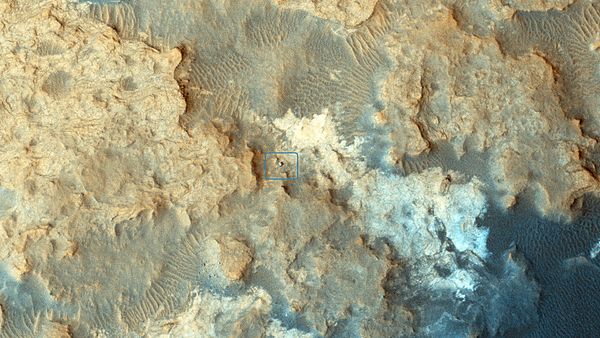
|

On 21 January 2015, NASA announced a collaborative effort with Microsoft that developed a software project called OnSight which allows scientists to perform virtual work on Mars based on data from the Curiosity rover.[165]
| Curiosity at Mount Sharp
|
|---|

Self-portrait of the Curiosity rover at the Mojave site (31 January 2015).
|
On 6 March 2015, NASA reported performing tests on the rover to help uncover the reason for intermittent problems with the robotic arm used for rock drilling and analysis.[166] Results of preliminary tests suggest the intermittent short-circuit problem may be related to the percussion mechanism of the drill. Further tests are planned to verify and adjust to the problem.[167]
On 24 March 2015, NASA reported the first detection of
On 27 March 2015, NASA reported that the landing site was fading from view in the two-and-a-half years since landing in 2012, as shown in the following animation:
On 4 April 2015, NASA reported studies, based on measurements by the Sample Analysis at Mars (SAM) instrument on the Curiosity rover, of the Martian atmosphere using xenon and argon isotopes. Results provided support for a "vigorous" loss of atmosphere early in the history of Mars and were consistent with an atmospheric signature found in bits of atmosphere captured in some Martian meteorites found on Earth.[169]
On 19 August 2015, NASA scientists reported that the Dynamic Albedo of Neutrons (DAN) instrument on the Curiosity rover detected an unusual hydrogen-rich area, at "Marias Pass," on Mars. The hydrogen found seemed related to water or hydroxyl ions in rocks within three feet beneath the rover, according to the scientists.[170]

On 5 October 2015, possible
On 8 October 2015, NASA confirmed that lakes and streams existed in Gale crater 3.3 - 3.8 billion years ago delivering sediments to build up the lower layers of Mount Sharp.[172][173]

(Curiosity rover; December 17, 2015).
On 17 December 2015, NASA reported that as Curiosity climbed higher up Mount Sharp, the composition of rocks were changing substantially. For example, rocks found higher up the mountain contained much higher levels of
Second extended mission (October 2016 - September 2019)
The second extended mission began on 1 October 2016.[175]
As of 3 October 2016, NASA summarized the findings of the mission, thus far, as follows: "The Curiosity mission has already achieved its main goal of determining whether the landing region ever offered environmental conditions that would have been favorable for microbial life, if Mars has ever hosted life. The mission found evidence of ancient rivers and lakes, with a chemical energy source and all of the chemical ingredients necessary for life as we know it."
On 13 December 2016, NASA reported further evidence supporting habitability on Mars as the Curiosity rover climbed higher, studying younger layers, on Mount Sharp.[178] Also reported, the very soluble element boron was detected for the first time on Mars.[178] Since landing on Mars in August 2012, Curiosity has driven 15.0 km (9.3 mi) and climbed 165 m (541 ft) in elevation.[179]



On 17 January 2017, NASA released an image of a rock slab, named "Old Soaker", which may contain mud cracks. Also, somewhat later, it released an animation of sand moving in a nearby area.
-
Rock slab, named "Old Soaker", which may contain mud cracks – as viewed by Curiosity (December 20, 2016).
-
Sand moving on Mars – as viewed by Curiosity (January 23, 2017).
On 6 February 2017, NASA reported that rock samples analyzed by the rover have not revealed any significant carbonate. This poses a puzzle to researchers: the same rocks that indicate a lake existed also indicate there was very little carbon dioxide in the air to help keep the lake unfrozen.[181]
On 27 February 2017, NASA presented the following mission overview: "During the first year after Curiosity's 2012 landing in Gale Crater, the mission fulfilled its main goal by finding that the region once offered environmental conditions favorable for microbial life. The conditions in long-lived ancient freshwater Martian lake environments included all of the key chemical elements needed for life as we know it, plus a chemical source of energy that is used by many microbes on Earth. The extended mission is investigating how and when the habitable ancient conditions evolved into conditions drier and less favorable for life."[182]
On 1 June 2017, NASA reported that the Curiosity rover provided evidence of an ancient lake in Gale crater on Mars that could have been favorable for microbial life; the ancient lake was stratified, with shallows rich in oxidants and depths poor in oxidants; and, the ancient lake provided many different types of microbe-friendly environments at the same time. NASA further reported that the Curiosity rover will continue to explore higher and younger layers of Mount Sharp in order to determine how the lake environment in ancient times on Mars became the drier environment in more modern times.[183][184][185]


Between 22 July – 1 August 2017, few commands were sent from the Earth to Mars since Mars was in conjunction with the sun.[187]
On 5 August 2017, NASA celebrated the fifth anniversary of the Curiosity rover mission landing, and related exploratory accomplishments, on the planet Mars.[188][189] (Videos: Curiosity's First Five Years (02:07); Curiosity's POV: Five Years Driving (05:49); Curiosity's Discoveries About Gale Crater (02:54))
On 5 September 2017, scientists reported that the Curiosity rover detected boron, an essential ingredient for life on Earth, on the planet Mars. Such a finding, along with previous discoveries that water may have been present on ancient Mars, further supports the possible early habitability of Gale Crater on Mars.[190][191]

On 13 September 2017, NASA reported that the Curiosity rover climbed an iron-oxide-bearing ridge called Vera Rubin Ridge (or Hematite Ridge) and will now start studying the numerous bright veins embedded in the various layers of the ridge, in order to provide more details about the history and habitability of ancient Mars.[192]
On 30 September 2017, NASA reported radiation levels on the surface of the planet Mars were temporarily doubled, and were associated with an aurora 25-times brighter than any observed earlier, due to a massive, and unexpected, solar storm in the middle of the month.[193]

On 17 October 2017, NASA announced the testing of its systems on Curiosity in an attempt to better resume drilling. The drilling system had stopped working reliably in December 2016.[194]

On 2 January 2018, Curiosity captured images of rock shapes that may require further study in order to help better determine whether the shapes are biological or geological.[195][196]

On 22 March 2018, Curiosity had spent 2000 sols (2054 days) on Mars,[197] and prepares to study a region of clay-bearing rocks.

In June 2018, a
(1:38; animation; 30 October 2018; file description
-
Mars (before/after) dust storm (July 2018)
On 4 June 2018, NASA announced that Curiosity's ability to drill has been sufficiently restored by engineers. The rover had experienced drill mechanical problems since December 2016.[203]

(31 May 2018/Sol 2068)[203]
On 7 June 2018, NASA announced a cyclical seasonal variation in atmospheric


Since 15 September 2018, a glitch in Curiosity's active computer (Side-B) has prevented Curiosity from storing science and key engineering data.[213] On 3 October 2018, the JPL began operating Curiosity on its backup computer (Side-A).[213] Curiosity will store science and engineering data normally using its Side-A computer until the cause of the glitch in Side-B is determined and remedied.[213]
On 4 November 2018, geologists presented evidence, based on studies in Gale Crater by the Curiosity rover, that there was plenty of water on early Mars.[215][216]

On 26 November 2018, Curiosity viewed a shiny object (named, "Little Colonsay") on Mars.[217] Although possibly a meteorite, further studies are planned to better understand its nature.
On 1 February 2019, NASA scientists reported that the Mars Curiosity rover determined, for the first time, the density of Mount Sharp in Gale crater, thereby establishing a clearer understanding of how the mountain was formed.[218][219]
On 4 April 2019, NASA released images of solar eclipses by the two moons of the planet Mars, Phobos (animation1) and Deimos (animation2), as viewed by the Curiosity rover on the planet Mars in March 2019.[220][221]
On 11 April 2019, NASA announced that the Curiosity rover on the planet Mars drilled into, and closely studied, a "clay-bearing unit" which, according to the rover Project Manager, is a "major milestone" in Curiosity's journey up Mount Sharp.[222]



During June 2019, while still studying the clay-bearing unit, Curiosity detected the highest levels of


Third extended mission (October 2019 - September 2022)
The third extended mission began on 1 October 2019 - the rover's 2544th sol on Mars.[226]
In October 2019, evidence, uncovered by the Curiosity rover on Mount Sharp, was reported of a 150 km (93 mi) wide ancient basin in Gale crater that once may have contained a salty lake.[227][228]

In January 2020, a report was presented that compared Curiosity at the time of its landing on Mars in 2012, with the rover over seven years later in 2020.[229]
In February 2020, scientists reported the detection of thiophene organic molecules by the Curiosity rover on the planet Mars. It is not currently known if the detected thiophenes — usually associated on Earth with kerogen, coal and crude oil — are the result of biological or non-biological processes.[230][231]
In April 2020, scientists began operating the rover remotely from their homes due to the COVID-19 pandemic.[232]
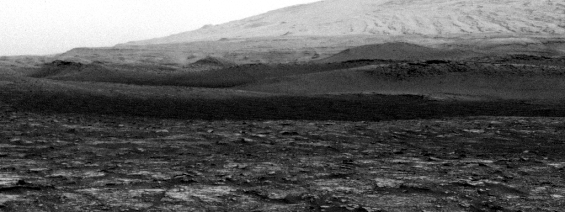
On 29 August 2020, NASA released several videos taken by the Curiosity rover, including those involving



In June 2021, scientists determined that the methane concentration around Curiosity varied according to the time of sol, with methane present only at night. This explains the difference in methane levels detected by Curiosity and the Trace Gas Orbiter (an open question since 2016), although it does not explain what is creating the methane or why the methane seems to be more short-lived than current models predict.[234] On 3 July 2021, the Curiosity rover viewed the "Rafael Navarro Mountain" area.

On 1 November 2021, astronomers reported detecting, in a "first-of-its-kind" process based on

On 17 January 2022, scientists reported finding an unusual signal of carbon isotopes on Mars by the Curiosity rover which may (or may not) be associated with ancient Martian life and suggesting, according to the scientists, that microbes residing underground may have emitted the "enriched carbon as methane gas". However, abiotic sources of the unusual carbon signal have not been completely ruled out.[237][238][239]
In April 2022, Mars Science Laboratory was renewed for a fourth extended mission, which will include the exploration of the sulfate-bearing unit.[240]



![Curiosity descending under its parachute (August 6, 2012; MRO/HiRISE).[51]](http://upload.wikimedia.org/wikipedia/commons/thumb/d/d2/MRO_sees_Curiosity_landing.jpg/120px-MRO_sees_Curiosity_landing.jpg)

![Engineers at NASA's Jet Propulsion Laboratory celebrate the landing.[52]](http://upload.wikimedia.org/wikipedia/commons/thumb/d/d5/Cheering_hq_msl20120805-br2.jpg/120px-Cheering_hq_msl20120805-br2.jpg)

![Curiosity landed on August 6, 2012,[37] about 10 km from the base of Mount Sharp).[53]](http://upload.wikimedia.org/wikipedia/commons/thumb/6/65/673885main_PIA15986-full_full.jpg/120px-673885main_PIA15986-full_full.jpg)



























!["Murray Buttes" knobs - Mount Sharp slopes (November 13, 2013).[123]](http://upload.wikimedia.org/wikipedia/commons/thumb/9/97/PIA17587-MarsCuriosityRover-MurrayButtes-20131113.jpg/120px-PIA17587-MarsCuriosityRover-MurrayButtes-20131113.jpg)



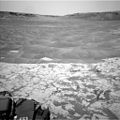
















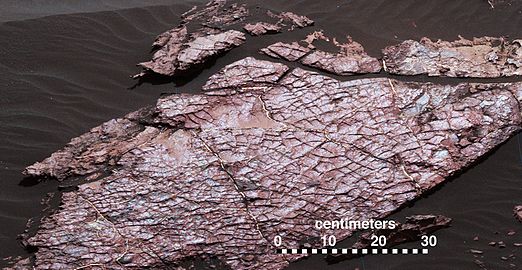
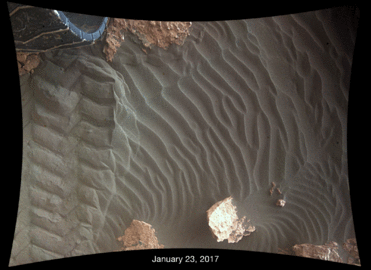

![Curiosity during dust storm[201][202]](http://upload.wikimedia.org/wikipedia/commons/thumb/b/ba/PIA22486-MarsCuriosityRover-DustStormSelfie-Sol2082-20180615.jpg/353px-PIA22486-MarsCuriosityRover-DustStormSelfie-Sol2082-20180615.jpg)





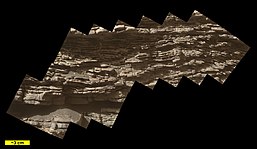



























![Estimate of ancient lake on Aeolis Palus in Gale Crater.[127][128]](http://upload.wikimedia.org/wikipedia/commons/thumb/a/a4/PIA17596-MarsCuriosityRover-AncientLake-20131209.jpg/120px-PIA17596-MarsCuriosityRover-AncientLake-20131209.jpg)


![Base of Aeolis Mons, an area of varied terran that Curiosity is expected to study.[252]](http://upload.wikimedia.org/wikipedia/commons/thumb/b/bb/PIA16068_-_Mars_Curiosity_Rover_-_Aeolis_Mons_-_20120817.jpg/120px-PIA16068_-_Mars_Curiosity_Rover_-_Aeolis_Mons_-_20120817.jpg)

![Curiosity finds a "bright object" in the sand at Rocknest (October 7, 2012)[74] (close-up).](http://upload.wikimedia.org/wikipedia/commons/thumb/6/6d/PIA16225-MarsCuriosityRover-ScooperTest%26MysteryObject-20121008a.jpg/120px-PIA16225-MarsCuriosityRover-ScooperTest%26MysteryObject-20121008a.jpg)

![Planet Mercury transiting the Sun as viewed by the Curiosity rover (June 3, 2014).[157]](http://upload.wikimedia.org/wikipedia/commons/thumb/c/cf/PIA18389-MarsCuriosityRover-MercuryTransitsSun-20140603.gif/120px-PIA18389-MarsCuriosityRover-MercuryTransitsSun-20140603.gif)









![Curiosity's view of a bright spot near "The Kimberley" (KMS-9; April 3, 2014).[253]](http://upload.wikimedia.org/wikipedia/commons/thumb/e/e3/PIA18077-MarsCuriosityRover-TheKimberley-BrightSpot-20140403.jpg/120px-PIA18077-MarsCuriosityRover-TheKimberley-BrightSpot-20140403.jpg)












